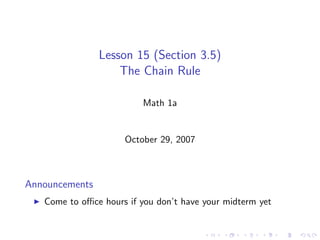
The area of a circle is given by A = πr^2. Taking the derivative of both sides with respect to time t, we get:dA/dt = d/dt(πr^2) = 2πr * dr/dtThe chain rule was used to take the derivative of πr^2. The correct answer is C
- 1. Lesson 15 (Section 3.5) The Chain Rule Math 1a October 29, 2007 Announcements Come to office hours if you don’t have your midterm yet
- 2. Analogy Think about riding a bike. To go faster you can either:
- 3. Analogy Think about riding a bike. To go faster you can either: pedal faster
- 4. Analogy Think about riding a bike. To go faster you can either: pedal faster change gears
- 5. Analogy Think about riding a bike. To go faster you can either: pedal faster change gears The angular position of the back wheel depends on the position of the front wheel: Rθ ϕ(θ) = r And so the angular speed of the back wheel depends on the derivative of this function and the speed of the front wheel.
- 7. Theorem of the day: The chain rule Theorem Let f and g be functions, with g differentiable at a and f differentiable at g (a). Then f ◦ g is differentiable at a and (f g ) (a) = f (g (a))g (a) ◦ In Leibnizian notation, let y = f (u) and u = g (x). Then dy dy du = dx du dx
- 8. Example Example 3x 2 + 1. Find h (x). let h(x) =
- 9. Example Example 3x 2 + 1. Find h (x). let h(x) = Solution First, write h as f g. ◦
- 10. Example Example 3x 2 + 1. Find h (x). let h(x) = Solution √ u and g (x) = 3x 2 + 1. First, write h as f g . Let f (u) = ◦
- 11. Example Example 3x 2 + 1. Find h (x). let h(x) = Solution √ First, write h as f ◦ g . Let f (u) = u and g (x) = 3x 2 + 1. Then f (u) = 1 u −1/2 , and g (x) = 6x. So 2 h (x) = 1 u −1/2 (6x) 2
- 12. Example Example 3x 2 + 1. Find h (x). let h(x) = Solution √ First, write h as f ◦ g . Let f (u) = u and g (x) = 3x 2 + 1. Then f (u) = 1 u −1/2 , and g (x) = 6x. So 2 3x h (x) = 1 u −1/2 (6x) = 2 (3x 2 + 1)−1/2 (6x) = √ 1 2 3x 2 + 1
- 13. Example 2 3 x5 − 2 + 8 Let f (x) = . Find f (x).
- 15. Example 2 3 x5 − 2 + 8 Let f (x) = . Find f (x). Solution d d 2 3 3 3 x5 − 2 + 8 x5 − 2 + 8 x5 − 2 + 8 =2 dx dx
- 16. Example 2 3 x5 − 2 + 8 Let f (x) = . Find f (x). Solution d d 2 3 3 3 x5 − 2 + 8 x5 − 2 + 8 x5 − 2 + 8 =2 dx dx d 3 3 x5 − 2 + 8 x5 − 2 =2 dx
- 17. Example 2 3 x5 − 2 + 8 Let f (x) = . Find f (x). Solution d d 2 3 3 3 x5 − 2 + 8 x5 − 2 + 8 x5 − 2 + 8 =2 dx dx d 3 3 x5 − 2 + 8 x5 − 2 =2 dx d5 − 2)−2/3 3 15 x5 − 2 + 8 (x − 5) =2 3 (x dx − 2)−2/3 (5x 4 ) 3 15 x5 − 2 + 8 =2 3 (x 10 4 x 5 − 2 + 8 (x 5 − 2)−2/3 3 = x 3
- 19. A metaphor Think about peeling an onion: 2 3 x 5 −2 +8 f (x) = 5 √ 3 +8 2 − 2)−2/3 (5x 4 ) 3 15 x5 − 2 + 8 f (x) = 2 3 (x
- 20. Question The area of a circle, A = πr 2 , changes as its radius changes. If the radius changes with respect to time, the change in area with respect to time is dA A. = 2πr dr dA dr B. = 2πr + dt dt dA dr C. = 2πr dt dt D. not enough information
- 21. Question The area of a circle, A = πr 2 , changes as its radius changes. If the radius changes with respect to time, the change in area with respect to time is dA A. = 2πr dr dA dr B. = 2πr + dt dt dA dr C. = 2πr dt dt D. not enough information
